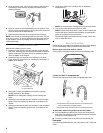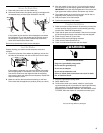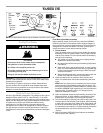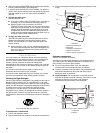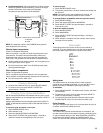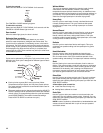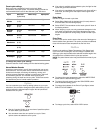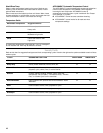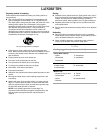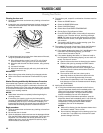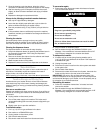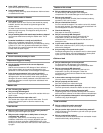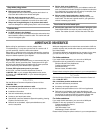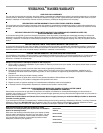
16
Wash/Rinse Temp
Select a water temperature based on the type of load you are
washing. Use the warmest wash water safe for fabrics. Follow
garment label instructions.
Warm rinses leave the loads dryer than cold rinses. Warm rinses
increase wrinkling. In cold climates, a warm rinse makes the load
more comfortable to handle. Cold rinses save energy.
Temperature Guide
In wash water temperatures colder than 60°F (15.6°C), detergents
do not dissolve well. Soils may be difficult to remove.
ACCUWASH™ Automatic Temperature Control
The ACCUWASH™ control electronically senses and maintains a
uniform water temperature. ACCUWASH control regulates
incoming hot and cold water. ACCUWASH control is
automatically turned On when a cycle is selected. See “Preset
cycle settings” in “Cycles.”
■ ACCUWASH™ control ensures consistent cleaning.
■ ACCUWASH™ control works for all wash and rinse
temperature settings.
Laundry Guide
Refer to this chart for suggested load types and their corresponding cycles. Listed to the right are the options available to each of these
washer cycles.
Wash Water Temperature Suggested Fabrics
HOT Whites and pastels
Heavy soils
WARM Bright colors
Moderate to light soils
COLD Colors that bleed or fade
Light soils
CYCLE SUGGESTED LOAD TYPE DELAY WASH RINSE HOLD
Whitest Whites Soiled white fabrics ✔✔
Heavy Duty Heavily soiled underwear, towels, shirts, etc. ✔✔
Normal/Casual Normally soiled blouses, shirts, overalls, etc., made of
polyester, nylon, cotton, linen, or cotton blends
✔✔
Delicate Curtains, delicate clothing, dresses, skirts, shirts and
blouses with “No-iron fabric,” “Permanent Press,” “Wrinkle
Free,” or “Gentle Cycle” on the care label
✔✔
Hand Washables Fabrics made of silk, special-care items marked as “Hand
Washable”
✔✔
Soak Fabrics made of cotton, linen, polyester or nylon
Rinse/Spin Fabrics made of cotton, linen, polyester or nylon ✔✔
Drain/Spin Fabrics made of cotton, linen, polyester or nylon



